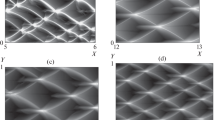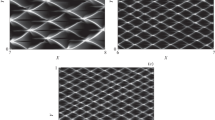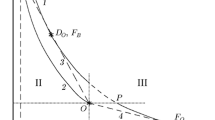Using a detailed kinetic mechanism of chemical interaction, the effect of adding argon and ozone to a stoichiometric hydrogen–air mixture on the detonation wave parameters was studied numerically. It has been established that the mole fractions of the used additions can be chosen so that the cell size of the detonation wave in the resulting mixture will be close to the average cell size in a pure hydrogen–air mixture, with the wave velocity and temperature of the detonation products being reduced significantly. It has been found that the detonation wave in a mixture with additives in selected concentrations is more stable against perturbations caused by multiple obstacles (barriers) located in the channel than in the initial mixture. The found specific features make it possible to consider the introduction of the indicated additives into the combustible mixture as a mechanism that lowers the temperature in the detonation wave without a significant increase in the detonation cell size and that prevents the extinction of detonation combustion in a channel with a number of barriers.
Similar content being viewed by others
References
V. A. Levin and T. A. Zhuravskaya, Controlling the position of a stabilized detonation wave in a supersonic flow of a gas mixture in a plane channel, Tech. Phys. Lett., 43, No. 3, 316–319; doi: https://doi.org/10.1134/S1063785017030191).
V. A. Levin and T. A. Zhuravskaya, Control of detonation combustion in a high-velocity gas mixture flow, in: Proc. V. A. Steklov Inst. Math., 300, 114–125 (2018); doi: https://doi.org/10.1134/S0081543818010091).
V. A. Levin and T. A. Zhuravskaya, The methods of control of stabilized detonation location in a supersonic gas flow in a plane channel, Combust. Sci. Technol., 195, No. 7, 1–13 (2019); doi: https://doi.org/10.1080/00102202.2018.1557641.
A. A. Vasil'ev, A. V. Pinaev, A. A. Trubitsyn, A. Yu. Grachev, A. V. Trotsyuk, P. A. Fomin, and A. V. Trilis, What is burning in coal mines: Methane or coal dust? Combust. Explos. Shock Waves, 53, No. 1, 8–14 (2017); doi: https://doi.org/10.1134/S0010508217010026).
V. A. Levin and T. A. Zhuravskaya, Detonation combustion control using preliminary preparation of the gas mixture, Tech. Phys. Lett, 46, No. 2, 189–192 (2020); doi: https://doi.org/10.1134/S1063785020020248).
T. A. Zhuravskaya and V. A. Levin, Control of a detonation wave in a channel with obstacles using preliminary gas mixture preparation, Fluid Dyn., 55, 488–497 (2020); doi: https://doi.org/10.1134/S0015462820040138).
. J. Cra ne, X. Sh i, A. V. Sing h, Y. Ta o, and H. Wang, Isolating the effect of induction length on detonation structure: Hydrogen–oxygen detonation promoted by ozone, Combust. Flame, 200, 44–52 (2019); doi: https://doi.org/10.1016/j.combustflame.2018.11.008).
M. A. Cherif, S. A. Shcherbanev, S. M. Starikovskaia, et al., Effect of non-equilibrium plasma on decreasing the detonation cell size, Combust. Flame, 217, 1–3 (2020); doi: https://doi.org/10.1016/j.combustflame.2020.03.014).
. F. Pintge n, C. A. Ecke tt, J. M. Austin , and J. E. Shepherd, Direct observations of reaction zone structure in propagating detonations, Combust. Flame, 133, Issue 3, 211–229 (2003); doi: https://doi.org/10.1016/S0010-2180(02)00458-3.
J. E. Shepherd, Detonation gases, in: Proc. Combust. Inst., 32, Issue 1, 83–98 (2009); doi: https://doi.org/10.1016/j.proci.2008.08.006.
D. S. Kumar, K. Ivin, and A. V. Singh, Sensitizing gaseous detonations for hydrogen/ethylene–air mixtures using ozone and H2O2 as dopants for application in rotating detonation engines, Proc. Combust. Inst., 38, Issue 3, 3825–3834 (2021); doi: https://doi.org/10.1016/j.proci.2020.08.061.
V. A. Levin and T. A. Zhuravskaya, Control of detonation combustion of a hydrogen–air mixture by argon and ozone addition, Dokl. Phys., 66, 320–324 (2021); doi: https://doi.org/10.1134/S1028335821110057).
L. V. Gurvich and I. V. Veyts (Eds.), Thermodynamic Properties of Individual Substances, Vol. 1, Part 2, New York: Hemisphere (1989).
L. V. Bezgin, V. I. Kopchenov, A. S. Sharipov, N. S. Titova, and A. M. Starik, Evaluation of prediction ability of detailed reaction mechanisms in the combustion performance in hydrogen/air supersonic flows, Combust. Sci. Technol., 185, Issue 1, 62–94 (2013); doi: https://doi.org/10.1080/00102202.2012.709562.
S. K. Godunov, A. V. Zabrodin, M. Ya. Ivanov, et al., Numerical Solution of Multidimensional Problems of Gas Dynamics [in Russian], Nauka, Moscow (1976).
V. P. Kolgan, Application of the principle of minimal values of the derivative to construction of finite-difference schemes for calculating discontinuous solutions of gas dynamics, Uch. Zap. TsAGI, 3, No. 6, 68–77 (1972).
Van Leer B, Towards the ultimate conservative difference scheme. IV. A new approach to numerical convection, J. Comput. Phys., 23, 276–299 (1977).
A. V. Rodionov, Monotonic scheme of the second order of approximation for the continuous calculation of nonequilibrium flows, USSR Comput. Math. Math. Phys., 27, Issue 2, 175–180 (1987); doi: https://doi.org/10.1016/0041-5553(87)90174-1).
Vl. Voevodin, A. Antonov, D. Nikitenko, P. Shvets, S. Sobolev, I. Sidorov, K. Stefanov, Vad. Voevodin, and S. Zhumatiy, Supercomputer Lomonosov-2: Large Scale, deep monitoring and fine analytics for the user community, Supercomp. Front. Innov., 6, No. 2, 4–11 (2019); doi: https://doi.org/10.14529/jsfi190201.
R. I. Soloukhin, Shock Waves and Detonations in Gases, Baltimore: Mono Book (1966).
J. H. S. Lee, The Detonation Phenomenon, Cambridge: Cambridge University Press (2008).
G. Yu. Bivol, S. V. Golovastov, and V. V. Golub, Detonation suppression in hydrogen–air mixtures using porous coatings on the walls, Shock Waves, 28, Issue 5, 1011–1018 (2018); https://doi.org/10.1007/s00193-018-0831-3.
O. V. Sharypov and Y. A. Pirogov, On the mechanism of weakening and breaking of gas detonation in channels with acoustically absorbing walls, Combust. Explos. Shock Waves, 31, Issue 4, 466–470 (1995); doi: https://doi.org/10.1007/BF00789368).
A. Teodorczyk and J. H. S. Lee, Detonation attenuation by foams and wire meshes lining the walls, Shock Waves, 4, Issue 4, 225–236 (1995); doi: https://doi.org/10.1007/BF01414988).
M. I. Radulescu and J. H. S. Lee, The failure mechanism of gaseous detonations: experiments in porous wall tubes, Combust. Flame, 131, Issues 1–2, 29–46 (2002); doi: http://dx.doi.org/https://doi.org/10.1016/S0010-2180(02)00390-5.
S. A. Zhdanok, P. N. Krivosheyev, and O. G. Penyaz'kov, Investigations of propagation and transition of detonation from porous medium to volume, Russ. J. Phys. Chem., 24, No. 7, 27–36 (2005).
S. A. Zhdanok, P. N. Krivosheev, M. Mbawara, and O. G. Penyaz′kov, Ranges of rates of supersonic combustion in a porous medium, J. Eng. Phys. Thermophys., 78, No. 4, 625–630 (2005); https://doi.org/10.1007/s10891-005-0106-6).
T. A. Zhuravskaya, Propagation of detonation waves in plane channels with obstacles, Fluid Dyn., 42, Issue 6, 987–994 (2007); doi: https://doi.org/10.1134/S0015462807060142).
O. V. Achasov and O. G. Penyaz′kov, Investigation of the dynamic properties of the cellular structure of a gas-detonation wave, J. Eng. Phys. Thermophys., 73, No. 5, 915–920 (2000); doi: https://doi.org/10.1007/BF02681580).
H. Qin, J. H. S. Lee, Z. Wang, and F. Zhuang, An experimental study on the onset processes of detonation waves downstream of a perforated plate, Proc. Combust. Inst., 35, Issue 2, 1973–1979 (2015); doi: http://dx.doi.org/https://doi.org/10.1016/j.proci.2014.07.056.
Author information
Authors and Affiliations
Corresponding author
Additional information
Translated from Inzhenerno-Fizicheskii Zhurnal, Vol. 96, No. 7, pp. 1792–1802, November–December, 2023.
Rights and permissions
Springer Nature or its licensor (e.g. a society or other partner) holds exclusive rights to this article under a publishing agreement with the author(s) or other rightsholder(s); author self-archiving of the accepted manuscript version of this article is solely governed by the terms of such publishing agreement and applicable law.
About this article
Cite this article
Levin, V.A., Zhuravskaya, T.A. Detonation Combustion of a Hydrogen–Air Mixture with Additives of Argon and Ozone. J Eng Phys Thermophy 96, 1759–1768 (2023). https://doi.org/10.1007/s10891-023-02846-2
Received:
Published:
Issue Date:
DOI: https://doi.org/10.1007/s10891-023-02846-2




